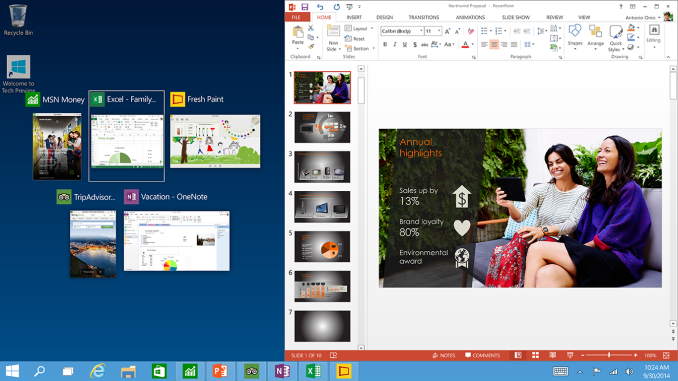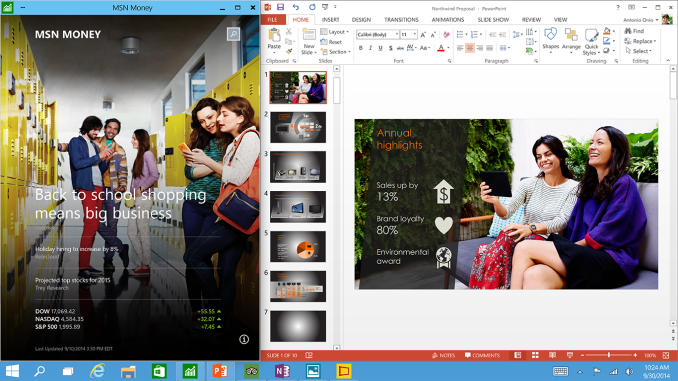Windows 10 Technical Preview First Impressions: The Return Of The Desktop
by Brett Howse on November 13, 2014 8:00 AM EST- Posted in
- Software
- Microsoft
- Windows 10
Closing Thoughts
If Windows 8 was “Touch First” then clearly Windows 10 is not. The current technical preview is very much geared towards the traditional mouse and keyboard user. This will change of course over the next several months, as the touch features get integrated back into Windows 10. As a user of all types of Windows devices, I welcome this change. It allows me to be more productive on my desktop, but still use the touch based Start Screen on a tablet or convertible notebook. Some good things have been done here to hopefully embrace the current user base, as well as new device types.
There are a number of features aimed squarely at businesses. If Microsoft wants to avoid another Windows XP with Windows 7 – where businesses do not migrate until they absolutely have to – then these features are certainly a carrot that may entice them to at least try it out. The Start Menu and other desktop additions will be great for the business users, and I think the IT crowd will be happy with a lot of the new additions around device management, identity management, and information management.
This is a technical preview of course, but still I would be remiss to not mention that it is not without its bugs. I have had a lot of issues with Windows Store apps, with many of them crashing especially when they are not the active window. Possibly there are some changes to the underlying WinRT framework for apps in standby but until we hear more about the framework changes then these problems will likely continue. More of this information should come out around the time of the next BUILD conference, scheduled for April 29th to May 1st 2015. Other issues with WinRT apps currently is that even though they can be used in a window, the absolute height of the window is limited. When Windows 8 was launched, WinRT apps were expecting to be either full screen, or snapped to the side. As such, the apps in a window must maintain a minimum height. Hopefully this can get sorted out in the future.
At first glance, Windows 10 looks like Windows 8 with a Start Menu. It is clearly a lot more than that, but even so, as someone very smart told me, that’s not a bad thing. Windows 8 had a lot going for it, but design decisions were made early on, and with a “my way or no way” attitude that it was difficult to use. It seems that Windows 10 really addresses a lot of this, while at the same time keeping and expanding on a lot of the great features that were in Windows 8 and likely overlooked due to a lot of animosity towards it.
The Windows Store is going to be a big part of this, and if the rumors of desktop apps being integrated into the store is true, then the OOBE for Windows 10 will be amazing. All of your settings and apps will now follow you from device to device, with a single log in. A lot of that is already there with Windows 8, but 10 should finish off the last remaining pieces if this is true. It makes a lot of sense, so unless the licensing terms are awful, this could be a fantastic addition to the store.
The Universal App model is also a big piece of the puzzle, but here there is more work to do. WinRT has a lot of advantages, but the framework needs to be updated at a rapid pace in order to draw developers in. It is somewhat seductive to be able to target desktops, laptops, tablets, phones, and the TV with Xbox One with a single application (with multiple interfaces of course) but until the framework is made powerful enough for more apps than just simple web front ends, it may be difficult to realize this idea. Once again, more info should be available at BUILD in regards to this.
I’ve also had some bugginess with the WinRT apps on Windows 8, which I hope will be fixed with Windows 10. At this point though, the WinRT apps are even buggier so likely there will be more pain before this is all corrected.
Although we have only seen the Technical Preview and a single update to it so far, you can see the potential for Windows 10 and what it will be able to accomplish. It is an ambitious goal to provide a single platform across such a swath of different devices, and one that was held back by the user interface before. With Continuum, it appears that it may be the best of both worlds. Even more exciting is how much more upfront and open Microsoft has been on this entire process, with not just the technical preview but also soliciting and requesting user feedback on the changes. One of the biggest change requests was a simple animation on the Start Menu, and that has already been implemented, so this really is a different world than when Windows 8 was given a sneak peek.
Due to the timing of the latest release that just came out, this article is based on the second build of Windows 10 and I have not had a chance to go over any of the changes in the latest built that arrived on November 12th.
Going forward, as we get more updates to the preview we will do our best to keep you fully informed with that the changes are, and how they will affect you. If you want to kick the tires of Windows 10 and you have not yet, just visit http://preview.windows.com and sign up for the technical preview.












198 Comments
View All Comments
Pork@III - Thursday, November 13, 2014 - link
Now back and aero interface and become ... well. For excellent results, however, it is necessary to hide the "Metro" even aside. It is still more harm than help.metayoshi - Thursday, November 13, 2014 - link
With regards to the Share feature on desktop, does the Windows Photo Viewer also have a share button? That would definitely be useful for sharing to Facebook or Twitter (or Instagram, if they ever implement a Windows app) instead of having to share from the Windows Explorer every time.Brett Howse - Thursday, November 13, 2014 - link
The "Photos" app supports this. I would think it unlikely they would add the Share contract in to the old one but at this rate - who knows.Chloiber - Thursday, November 13, 2014 - link
As a person who works in a small start up that uses a lot of Microsoft hardware and software, the new business features sound awesome. We are getting to a point where we need management systems but many existing ones are simply too expensive for only a handful of people and require (again) hardware, software and someone probably needs to invest several days or weeks to set things up correctly. So this really comes in handy and I'm looking forward to it!Regarding the server OSes, I think they did many things right with Windows Server 2012 R2, but there are still some things (usability wise) that need improvements.
Taurus229 - Thursday, November 13, 2014 - link
I still say that Windows 7 is much more user friendly. Just look at where Microsoft has placed the shutdown, restart button. Common sense says that Microsoft did not put much thought into that change! Microsoft still has to make it as user friendly as Windows 7 to achieve acceptance.Chloiber - Thursday, November 13, 2014 - link
I have to agree on this one. I always used my keyboard with Windows 7 to shutdown/restart/standby my machines. Win -> ArrowRight -> (ArrowUp/Down) -> Enter. It was terrible in Windows 8 / Windows Server 2012 and got a bit better in 8.1 / 2012 R2. In Windows 10 it's basically the same as in 8.1...inighthawki - Thursday, November 13, 2014 - link
Or, you know, make it customizable? Let the user drag and drop components onto their start menu however they see fit. Isn't that the entire goal - start is personal?lilmoe - Thursday, November 13, 2014 - link
I love the way windows snap right and left now. When you snap a window to the left, re-size it, and try to snap another to the right, the new window will snap filling all the space made available by re-sizing the first window. Cool.This is great when you're trying to snap 2 windows only. However (and I did write to Microsoft about it), when you're trying to snap 3 or more windows (columns of windows), it would be nice if the third window automatically snapped in the vacant space made by resizing any of the previous ones. Would be awesome, especially when you're trying to display several windows together since screens are really wide nowadays.
crabperson - Thursday, November 13, 2014 - link
I never understood why the app switcher mechanism in Windows 8 wasn't fused with the classic taskbar. It seems like there's a 'touch' taskbar you can pull up using a gesture, and a separate taskbar for windows on the desktop. It makes even less sense now that apps show up on both in 8.1, yet the Desktop is still an app on the touch version.Couldn't you just swipe from whatever side of the screen the taskbar is on to see the app previews (or even the existing aero previews), and keep swiping to pull the app to the foreground, whether its a fullscreen touch app or a standard application window? Then the charms and menu gestures can be moved to whatever sides of the screen that are free, for the 5% of people that move the taskbar around.
stephenbrooks - Sunday, November 16, 2014 - link
Glad I'm not the only one who wondered why they weren't more unified.While we're unifying things, why not have an option for the Win8-style Start screen to *be* your desktop? It basically replaces "putting a load of application shortcuts on your desktop" anyway.